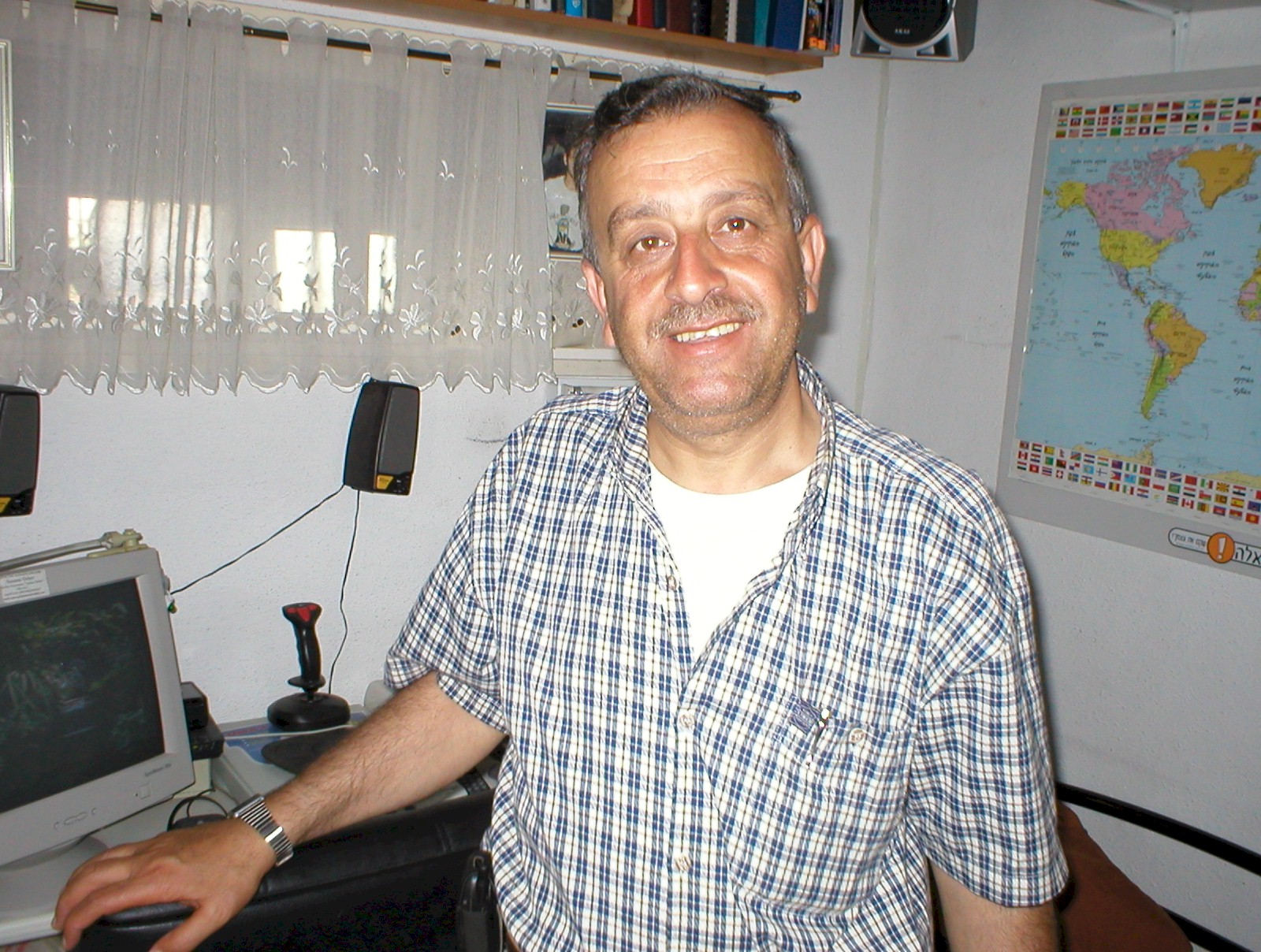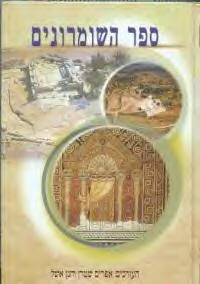|
August 15, 2002
*Samir Sirrawi, A Samaritan Teacher
*Stolen Samaritan Torah Scrolls most likely still held in Jordan
*Salameh b. Ghazal the high priest and Hussein' Abd U-Hadi, the Governor of Nablus
*Mark Twain and His Secret Document
*New Hebrew Book on the Market
and to our
Have you read
Who will help the Good Samaritans?
by Judith Fein
Coming soon to our web site:
SALAMEH B. GHAZAL, THE HIGH PRIEST AND HUSSEIN’ABD U-HADI, THE GOVERNOR OF NABLUS By Haseeb Shehadeh [University of Helsinki] Read an interesting article:
A Hill and Its King
And Read: The Tsedaka Family: One of the Most Active Elements in the Samaritan Community in the 20th Century by Nathan Schur.
The Return of the Diaspora Samaritans to Nablus at the End of the Middle Ages by Nathan Schur.
Our
Store is Open, Come on in! CD of the Samaritan Singers, Check it out today! Or if you are looking for something different. Interested parties can contact us at webmaster@The-Samaritans.com The Third Edition of " A Bibliography of the Samaritans" should be on sale later this year. Watch for it!
Get a free E-mail Address from www.The-Samaritans.com/ . Just go to our web site and find “get a free e-mail address” or go to http://samaritan.i-p.com/ and register. Let people know you are involved with the Samaritans. Subscribe to the A. B.- The Samaritan News- Since December 1969. A Bi-Weekly Newspaper, Written in Four Languages.POB 1029, Holon 58 110, Israel or E-mail Benyamim and Yefet Tsedaka: tsedakab@netvision.net.il
Back Issues Are
Available. 'The Samaritan Discussion.' Ask questions and post you views! Come Join Us! |
Samir Sirrawi, A Samaritan Teacher
Samir Sirrawi
For further information on purchasing the Samaritan Torah on computer data contact:
The
first version: Baruch Marchiv, Ben Amram St. 17a,Holon 58846. The second
and the third - by Israel Tsedaka, 7a Ben-Amram St. Holon 58846. Orders
directed to both mentioned. Many copies Stolen Samaritan Torah Scrolls most likely still held in JordanIn March, 1995, an unnumbered group of men entered the Samaritan synagogue and stole two Samaritan manuscripts, one a scroll and the other a bound codex. The Samaritans were entering the synagogue for morning worship and found that it had been broken into. The Israeli and Palestinian Authority was contacted immediately but with no results. The two men having escaped Mount Gerizim demanded a ransom of seven million dollars for the two stolen treasures. PA Chairman Yasser Arafat somehow preceded in getting the robbers to reduce the demand to two million dollars. It was also learned that the scrolls had been smuggled into Amman, Jordan. In August, 1997, Priest Shalom (currently High Priest) had seen the two manuscripts intact when he went to Amman for the purpose of procuring the stolen property. He was told that the ransom was reduced to one million dollars. The Samaritans were hoping that there would be some chance of obtaining their property but the amount that the thieves requested was to high a price. It is not that the Samaritans do not value the manuscripts, but they have no means of obtaining such a large amount of money with common incomes. A report of the stolen manuscripts was reported to the Jordanian police, but as of yet no results have been made to this day on bringing the thieves to justice. The manuscripts were stored in a large suitcase by the thieves and hopefully are still intact.Nothing has happened with the manuscripts to date that we know of but High Priest Shalom has made the scrolls his personal commitment to see that they are returned to the synagogue.This is not the first time a thief has taken place concerning sacred scrolls, according to Moses Gaster as he writes in his book, "I have been told that this case, which is of copper (or brass), is a copy made in the seventeenth century from an older case which was in silver, and of which the Samaritans had been robbed by the Arabs in Shechem."ShomronSALAMEH B. GHAZAL, THE HIGH PRIEST AND HUSSEIN’ABD U-HADI, THE GOVERNOR OF NABLUS By Haseeb Shehadeh [University of Helsinki] In this article I deal with the second and last story about the Samaritan high priest Salama b. Imram b. Ghazal b. Ishaq b. Sadaqa (1784-1855) as found in the hand-written book, Kitab al-Samiriyyin, by the Samaritan high priest Yaqub b. Shafiq (‘Uzzi) b. Yaqub b. Harun b. Salama b. Ghazal (1899-1987). English Translation: The Story of Salama the Priest with Husain ‘Abd al-Hadi This is another story about Salama the Priest which again bears witness to his repeated miracles and connections. We hand it down faithfully as we heard it without addition or omission. It is known that Salama the Priest was a neighbour and a close friend of the commander Husain ‘Abd al-Hadi. Only a wall separated their two houses, which would become one house if a door were to be built in that wall. Al-Husain intended to do just that. When the bonds of friendship consolidated between them and their mutual visits increased, Al-Husain decided to build a door. When he consulted his friend Salama about this matter Salama answered him with his known simplicity and good intention, and said: “Oh Husain, do you need to ask or consult? There is no difference between me and you at all. Do what seems good for you.” But al-Husain wanted the approval of the priest’s son ‘Imran because he feared that ’Imran might not agree or might have a conflict with his father because of that. Therefore, he invited the son in order to hear his opinion. The son, who was at that time young and clever, came. Al-Husain presented the matter to him and said: “We both, I and your father have become old and we can hardly bear to be separated. We agreed to open a door between us to shorten the distance of going around the whole house, for this troubles both of us particularly during the night visits. What is your opinion, my son?” (Article courtesy of A. B. News Services.) You can find the full story at our website along with the first article by Dr. Shehadeh. Mark Twain And His Secret Document Samuel Langhorne Clemens also know as the Mark Twain, a famous author of such works as Huckleberry Finn, the adventures of Tom Sawyer, A Connecticut Yankee in King Arthur's Court to mention a few. He also wrote a book of his travels in the Holy Land entitled, Innocents Abroad: Mark Twain visits Palestine in 1867. In this book in Chapter fifty-two, there is a short paragraph of his encounter with the Samaritans. It reads as follows: "Carefully preserved among the sacred archives of this curious community is a MSS. copy of the ancient Jewish law, which is said to be the oldest document on earth. It is written on vellum, and is some four to five thousand years old. Nothing but bucksheesh can purchase a sight. Its fame is somewhat dimmed in these latter days, because of the doubt of so many authors of Palestine travels have felt themselves privileged to cast upon it. Speaking of this MSS. reminds me that I procured from the high priest of this ancient Samaritan community, at great expense, a secret document of still higher antiquity and far more extraordinary interest, which I propose to publish as soon as I have finished translating it." Did he really visit the Samaritans and see the real Abisha Scroll in which he made reference? So what was this old manuscript that Twain so claims to have purchased from the high priest who had to have been Amram b. Shalma (high priest from 1855-1874)
As for the 'secret document of still higher antiquity' that he purchased from high priest Amram, what was it?. Twain does not inform us of its contain, only that he will publish it after translating it. Pursuing to locate the manuscript, I contacted Peter Knapp, the Special Collections Librarian and College Archivist at Watkinson Libary, Trinity College, Hartford, CT. In a response he informed me that, 'We have no information in our collections nor in the Mark Twain House's collection of Twain manuscripts and other materials that are temporarily on deposit here.' He suggested I contact the 'staff of the Mark Twain Papers and Project at the Bancroft Library, University of California, Berkeley, for assistance. The Bancroft Library has by far the largest and most comprehensive collection of materials on Twain, including correspondence, notebooks, manuscripts of his publications, etc. I believe they also have been gathering photocopies of Twain materials held at other repositories in connection with their research needs.' I contacted them. While waiting to hear a reply, I returned to the internet for further investigation of Twain's works. I found an article, 'Eve's Diary Translated from the Original Ms.' (Harper, 1906). Was this the document that Twain obtained from the priest or was this just another of Twain's imaginative stories? Still another work entitled, 'Extracts from Adam's Diary' (Harper, 1904) turned out to be a satire. But the words still returned to me, 'translated from the original MS.' What manuscript was Twain referring to? Eve's Diary is biblically sounding like it is related but upon reviewing the article I found on the net, it did not appear to be written in any style that resembled any book found in relation to be biblical. A response came back from Neda Salem, an assistant from MTP at the Bancroft Library concerning the question of the manuscript that Mark Twain wrote about in Innocents Abroad; 'This manuscript doesn't exist; its Twain making fun of tourist's gullibility. It would be great if it existed-- and we had it--but we don't.' So, the only question remains: What manuscript was Eve's Diary translated from? I returned the question back to Neda Salem and waited for her reply, but never received one. Shomron --------- [NOTE. -- I translated a portion of this diary some years ago, and a friend of mine printed a few copies in an incomplete form, but the public never got them. Since then I have deciphered some more of Adam's hieroglyphics, and think he has now become sufficiently important as a public character to justify this publication. -- Mark. Twain.] Extracts From Adam's Diary TRANSLATED FROM THE ORIGINAL MS.By Mark Twain, Illustrated by F. Strothmann http://www.boondocksnet.com/twaintexts/adam/index.htmlEve's Diary Translated from the Original Ms.
http://www.boondocksnet.com/twaintexts/eve/index.html
The latest book,
The Samaritans has been written in
Thank you! We would like to thank you for visiting our website, www.The-Samaritans.com in the past and hope you visit us again real soon. We ask you to forward this Update to your friends. The purpose at our web site is the education of the existence and history of the Samaritan-Israelites, descendants of the ancient Kingdom of Israel. Recently we have been working on expanding our web site. We do hope you enjoy visiting our site and recommend it to your friends. Again we thank you for visiting us at www.The-Samaritans.com . Take care and may you be blessed from the Holy One from above. |

 a
very talented teacher, invests much of his time educating the Samaritan
young on a daily basis. One of many Samaritan teachers, Samir enjoys
teaching the Samaritan tradition to the Samaritan children. In his spare
time, Samir has transcribed the Samaritan Torah onto computer data. This
could be of great value to the public that are interested in the Samaritan
Pentateuch. Because of the veneration that the Samaritans give their Torah
it makes it almost impossible to mail or ship the Pentateuch to an
interested party throughout the world. Samir's information may be a
catalyst for solving the problem of many interested parties that want to see and learn
the Samaritan Torah. Benymim Tsedaka reveals: "This is the forth
Samaritan-Israelite Torah that has been published since 1985. The first
was by the Committee of the Samaritan Community in Holon, the second and
third by Israel Tsedaka of Holon. None of these four Torahs have received
public confirmation and were a result of private or self initiative." Many
numerous requests for the Torah have come to us through our web site over the years. If it is permissible by the Samaritans to
place their Samaritan Torah on the internet even at a cost, it would be of great value,
not just for the internet audience but also of a greater significance for
establishing the Samaritan version of the Pentateuch as an accepted holy
write along side the Messoric text. The next step would be a comparison
between the Samaritan and Jewish version and then an English translation,
which has been numerously requested. (Photo by Osher Sassoni) Shomron
a
very talented teacher, invests much of his time educating the Samaritan
young on a daily basis. One of many Samaritan teachers, Samir enjoys
teaching the Samaritan tradition to the Samaritan children. In his spare
time, Samir has transcribed the Samaritan Torah onto computer data. This
could be of great value to the public that are interested in the Samaritan
Pentateuch. Because of the veneration that the Samaritans give their Torah
it makes it almost impossible to mail or ship the Pentateuch to an
interested party throughout the world. Samir's information may be a
catalyst for solving the problem of many interested parties that want to see and learn
the Samaritan Torah. Benymim Tsedaka reveals: "This is the forth
Samaritan-Israelite Torah that has been published since 1985. The first
was by the Committee of the Samaritan Community in Holon, the second and
third by Israel Tsedaka of Holon. None of these four Torahs have received
public confirmation and were a result of private or self initiative." Many
numerous requests for the Torah have come to us through our web site over the years. If it is permissible by the Samaritans to
place their Samaritan Torah on the internet even at a cost, it would be of great value,
not just for the internet audience but also of a greater significance for
establishing the Samaritan version of the Pentateuch as an accepted holy
write along side the Messoric text. The next step would be a comparison
between the Samaritan and Jewish version and then an English translation,
which has been numerously requested. (Photo by Osher Sassoni) Shomron Twain
wrote that the scroll he had heard about was 'written on Vellum.' The Abisha
scroll is written on skins from peace offerings (animal skins) while
modern copies of the Torah were written on paper like the vellum scroll
Twain may have seen. The Samaritans admit that the real Abisha scroll was
sometimes substituted with a different scroll in which would explain Twain's
reference of vellum. Twain had not seen the real ancient scroll at all.
Besides this fact that he made a reference also that he said it was the
'ancient Jewish law' could indicate that he had not actually met the high
priest, Amram who would have argued the statement. It could have been
possible that his guide could have informed him of the Samaritans and the
scroll. Twain wrote so little concerning the Samaritans in his book. The
Samaritans surely would have given Twain an impression worth more than
this small paragraph.
Twain
wrote that the scroll he had heard about was 'written on Vellum.' The Abisha
scroll is written on skins from peace offerings (animal skins) while
modern copies of the Torah were written on paper like the vellum scroll
Twain may have seen. The Samaritans admit that the real Abisha scroll was
sometimes substituted with a different scroll in which would explain Twain's
reference of vellum. Twain had not seen the real ancient scroll at all.
Besides this fact that he made a reference also that he said it was the
'ancient Jewish law' could indicate that he had not actually met the high
priest, Amram who would have argued the statement. It could have been
possible that his guide could have informed him of the Samaritans and the
scroll. Twain wrote so little concerning the Samaritans in his book. The
Samaritans surely would have given Twain an impression worth more than
this small paragraph. Hebrew by
Ephraim Stern and Hanan Eshel, publication by Ben Zvi Institute in
Israel. The book details the story of the Samaritan communities
displaying their uniqueness in the world. The community of Kumran (the
location of the find of the Dead Sea Scrolls) is shown in relation to the
Samaritan communities.
Hebrew by
Ephraim Stern and Hanan Eshel, publication by Ben Zvi Institute in
Israel. The book details the story of the Samaritan communities
displaying their uniqueness in the world. The community of Kumran (the
location of the find of the Dead Sea Scrolls) is shown in relation to the
Samaritan communities.